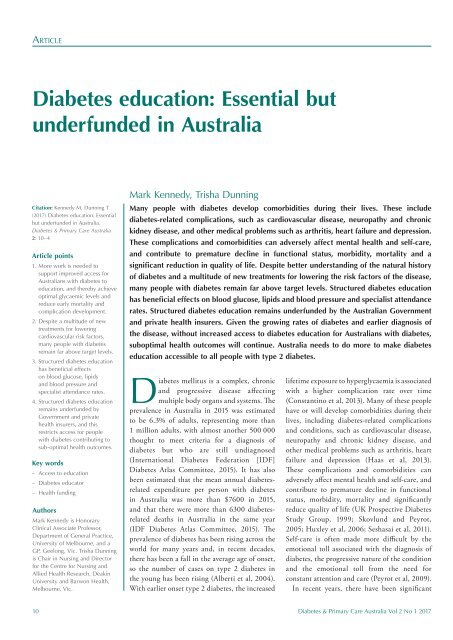DPCA2-1
You also want an ePaper? Increase the reach of your titles
YUMPU automatically turns print PDFs into web optimized ePapers that Google loves.
Article<br />
Diabetes education: Essential but<br />
underfunded in Australia<br />
Citation: Kennedy M, Dunning T<br />
(2017) Diabetes education: Essential<br />
but underfunded in Australia.<br />
Diabetes & Primary Care Australia<br />
2: 10–4<br />
Article points<br />
1. More work is needed to<br />
support improved access for<br />
Australians with diabetes to<br />
education, and thereby achieve<br />
optimal glycaemic levels and<br />
reduce early mortality and<br />
complication development.<br />
2. Despite a multitude of new<br />
treatments for lowering<br />
cardiovascular risk factors,<br />
many people with diabetes<br />
remain far above target levels.<br />
3. Structured diabetes education<br />
has beneficial effects<br />
on blood glucose, lipids<br />
and blood pressure and<br />
specialist attendance rates.<br />
4. Structured diabetes education<br />
remains underfunded by<br />
Government and private<br />
health insurers, and this<br />
restricts access for people<br />
with diabetes contributing to<br />
sub-optimal health outcomes.<br />
Key words<br />
– Access to education<br />
– Diabetes educator<br />
– Health funding<br />
Authors<br />
Mark Kennedy is Honorary<br />
Clinical Associate Professor,<br />
Department of General Practice,<br />
University of Melbourne, and a<br />
GP, Geelong, Vic. Trisha Dunning<br />
is Chair in Nursing and Director<br />
for the Centre for Nursing and<br />
Allied Health Research, Deakin<br />
University and Barwon Health,<br />
Melbourne, Vic.<br />
Mark Kennedy, Trisha Dunning<br />
Many people with diabetes develop comorbidities during their lives. These include<br />
diabetes-related complications, such as cardiovascular disease, neuropathy and chronic<br />
kidney disease, and other medical problems such as arthritis, heart failure and depression.<br />
These complications and comorbidities can adversely affect mental health and self-care,<br />
and contribute to premature decline in functional status, morbidity, mortality and a<br />
significant reduction in quality of life. Despite better understanding of the natural history<br />
of diabetes and a multitude of new treatments for lowering the risk factors of the disease,<br />
many people with diabetes remain far above target levels. Structured diabetes education<br />
has beneficial effects on blood glucose, lipids and blood pressure and specialist attendance<br />
rates. Structured diabetes education remains underfunded by the Australian Government<br />
and private health insurers. Given the growing rates of diabetes and earlier diagnosis of<br />
the disease, without increased access to diabetes education for Australians with diabetes,<br />
suboptimal health outcomes will continue. Australia needs to do more to make diabetes<br />
education accessible to all people with type 2 diabetes.<br />
Diabetes mellitus is a complex, chronic<br />
and progressive disease affecting<br />
multiple body organs and systems. The<br />
prevalence in Australia in 2015 was estimated<br />
to be 6.3% of adults, representing more than<br />
1 million adults, with almost another 500 000<br />
thought to meet criteria for a diagnosis of<br />
diabetes but who are still undiagnosed<br />
(International Diabetes Federation [IDF]<br />
Diabetes Atlas Committee, 2015). It has also<br />
been estimated that the mean annual diabetesrelated<br />
expenditure per person with diabetes<br />
in Australia was more than $7600 in 2015,<br />
and that there were more than 6300 diabetesrelated<br />
deaths in Australia in the same year<br />
(IDF Diabetes Atlas Committee, 2015). The<br />
prevalence of diabetes has been rising across the<br />
world for many years and, in recent decades,<br />
there has been a fall in the average age of onset,<br />
so the number of cases on type 2 diabetes in<br />
the young has been rising (Alberti et al, 2004).<br />
With earlier onset type 2 diabetes, the increased<br />
lifetime exposure to hyperglycaemia is associated<br />
with a higher complication rate over time<br />
(Constantino et al, 2013). Many of these people<br />
have or will develop comorbidities during their<br />
lives, including diabetes-related complications<br />
and conditions, such as cardiovascular disease,<br />
neuropathy and chronic kidney disease, and<br />
other medical problems such as arthritis, heart<br />
failure and depression (Haas et al, 2013).<br />
These complications and comorbidities can<br />
adversely affect mental health and self-care, and<br />
contribute to premature decline in functional<br />
status, morbidity, mortality and significantly<br />
reduce quality of life (UK Prospective Diabetes<br />
Study Group, 1999; Skovlund and Peyrot,<br />
2005; Huxley et al, 2006; Seshasai et al, 2011).<br />
Self-care is often made more difficult by the<br />
emotional toll associated with the diagnosis of<br />
diabetes, the progressive nature of the condition<br />
and the emotional toll from the need for<br />
constant attention and care (Peyrot et al, 2009).<br />
In recent years, there have been significant<br />
10 Diabetes & Primary Care Australia Vol 2 No 1 2017
















